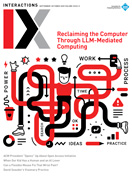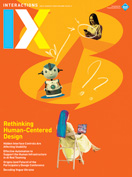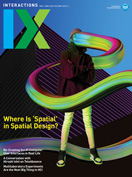Authors:
Mikael Wiberg, Elizabeth F. Churchill
As we approach the end of 2025, it is striking to realize that we are now firmly in the age of artificial intelligence. Across a number of technological waves—including symbolic AI, machine learning, deep learning, and now generative AI—we have learned that AI has brought about not only new capabilities but also new social practices. Still, what defines these social contexts rarely endures. As Donald Schön pointed out, "there is no stable state." Rather, we're living through a transformation that continues to reshape our ever-changing society. By 2035, as the authors of one article in this issue provocatively suggest, we may no longer be talking about GenAI at all. It will have settled into the background of everyday life—normalized, invisible, embedded, and perhaps unquestioned. Or, as Mark Weiser once said, "The most profound technologies are those that disappear. They weave themselves into the fabric of everyday life until they are indistinguishable from it."
This passing of technological eras mirrors the changes experienced by different generations. Generative tools are as natural to students entering college now as the Internet was to students 20 years ago. Those who pioneered HCI and design research in the 1980s and 1990s are now witnessing how our field is redefined once again. Across these generations, we see shifts in how creativity, authorship, and responsibility are understood. What does it mean to design when the tools themselves are generative? What does it mean to teach, to research, or to critique when AI is as ordinary and as embedded as electricity?
Looking ahead to 2035, the challenge is not simply to predict what will change, but to decide how to move forward and what we want to carry into the future.
Our cover story, "We Won't Be Talking About GenAI in 2035, and That's a Problem," by Eva Eriksson, Lone K. Hansen, and Peter Dalsgaard, takes this long view. When technologies fade into the fabric of everyday life, they argue, the conversations that once shaped their ethical and social contours risk fading too. The authors call on our community to keep the conversation going to sustain reflection, critique, and care even when novelty has worn off.
This theme of reimagining the future also runs through our other feature articles. In "Redesigning Success: How Post-Growth Economics Can Reshape the Games Industry," Samantha Stahlke, Tanner Mirrlees, and Pejman Mirza-Babaei invite us to think beyond growth metrics toward creative sustainability. Alice Ashcroft and Clàudia Figueras Julián's "Values, Ethics, and Intersectional Language Modeling in AI" exposes the social power dynamics embedded in large language models and advocates for a more inclusive, intersectional approach to AI ethics. Finally, Nischal Subedi's "Empowering Tenants and Landlords Through Conversational AI for Housing Rights" shows how AI can support social equity if it is designed with transparency and civic sensitivity.
Throughout the issue, our contributors return to the human element in an AI-saturated society. "Why Analog Tools Still Matter in an AI World," by our new columnist Tiffany Knearem, reminds us that the tactile, material, and slow still have value. Melissa Gregg reflects on the hardware afterlives that anchor our digital futures in material realities. And Jon Kolko's Design in Practice column grounds the next generation of designers in the realities of a profession that must coexist with automation.
As we approach the end of 2025, we find ourselves at a generational threshold. Looking ahead to 2035, the challenge is not simply to predict what will change, but to decide how to move forward and what we want to carry into the future—in terms of hopes, dreams, and sensibilities that make our interactive technologies human.
As always, we invite you to join the conversation. Interactions is a community platform, and it thrives on sharing diverse perspectives. You can find information regarding our submission guidelines at https://interactions.acm.org/submissions.
Mikael Wiberg and Elizabeth F. Churchill
[email protected]
Copyright 2025 held by owners/authors
The Digital Library is published by the Association for Computing Machinery. Copyright © 2025 ACM, Inc.








Post Comment
No Comments Found